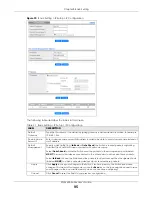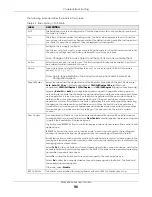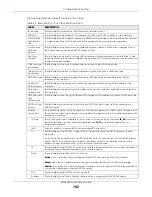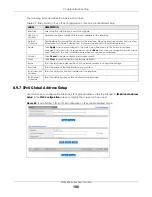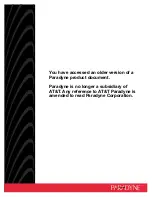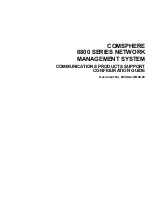
Chapter 8 Basic Setting
XGS4600 Series User’s Guide
91
The following table describes the labels in this screen.
Table 17 Basic Setting > Switch Setup
LABEL
DESCRIPTION
VLAN Type
(Standalone
mode only)
Choose
802.1Q
or
Port Based
. The
VLAN Setup
screen changes depending on whether you
choose
802.1Q
VLAN type or
Port Based
VLAN type in this screen.
The Switch does not have port-based VLAN available in stacking mode (
Active
is enabled in
Basic Setting
>
Stacking
>
Configuration
), so this field does not display in stacking mode.
Bridge Control
Protocol
Transparency
Select
Active
to allow the Switch to handle bridging control protocols (STP, for example). You
also need to define how to treat a BPDU in the
Port Setup
screen.
MAC Address Learning
MAC address learning reduces outgoing traffic broadcasts. For MAC address learning to occur on a port, the port
must be active.
Aging Time
Enter a time from 10 to 1000000 seconds. This is how long all dynamically learned MAC
addresses remain in the MAC address table before they age out (and must be relearned).
ARP Aging Time
Aging Time
Enter a time from 60 to 1000000 seconds. This is how long dynamically learned ARP entries
remain in the ARP table before they age out (and must be relearned). The setting here applies
to ARP entries which are newly added in the ARP table after you click
Apply
.
GARP Timer: Switches join VLANs by making a declaration. A declaration is made by issuing a
Join
message using
GARP. Declarations are withdrawn by issuing a
Leave
message. A
Leave All
message terminates all registrations.
GARP timers set declaration timeout values. See the chapter on VLAN setup for more background information.
Join Timer
Join Timer sets the duration of the Join Period timer for GVRP in milliseconds. Each port has a
Join
Period
timer. The allowed
Join Time
range is between 100 and 65535 milliseconds; the default is
200 milliseconds. See the chapter on VLAN setup for more background information.
Leave Timer
Leave Time sets the duration of the
Leave Period
timer for GVRP in milliseconds. Each port has a
single
Leave Period
timer. Leave Time must be two times larger than
Join Timer
; the default is 600
milliseconds.
Leave All Timer
Leave All Timer sets the duration of the Leave All Period timer for GVRP in milliseconds. Each port
has a single Leave All Period timer. Leave All Timer must be larger than Leave Timer.
Priority Queue Assignment
IEEE 802.1p defines up to eight separate traffic types by inserting a tag into a MAC-layer frame that contains bits to
define class of service. Frames without an explicit priority tag are given the default priority of the ingress port. Use
the next fields to configure the priority level-to-physical queue mapping.
The Switch has eight physical queues that you can map to the eight priority levels. On the Switch, traffic assigned to
higher index queues gets through faster while traffic in lower index queues is dropped if the network is congested.
Priority Level (The following descriptions are based on the traffic types defined in the IEEE 802.1d standard (which
incorporates the 802.1p).
To map a priority level to a physical queue, select a physical queue from the drop-down menu on the right.
Priority 7
Typically used for network control traffic such as router configuration messages.
Priority 6
Typically used for voice traffic that is especially sensitive to jitter (jitter is the variations in delay).
Priority 5
Typically used for video that consumes high bandwidth and is sensitive to jitter.
Priority 4
Typically used for controlled load, latency-sensitive traffic such as SNA (Systems Network
Architecture) transactions.
Priority 3
Typically used for “excellent effort” or better than best effort and would include important
business traffic that can tolerate some delay.
Priority 2
This is for “spare bandwidth”.
Priority 1
This is typically used for non-critical “background” traffic such as bulk transfers that are allowed
but that should not affect other applications and users.
Содержание XGS4600 Series
Страница 24: ...24 PART I User s Guide ...
Страница 44: ...44 PART II Technical Reference ...
Страница 180: ...Chapter 13 Spanning Tree Protocol XGS4600 Series User s Guide 180 Figure 145 MSTP and Legacy RSTP Network Example ...
Страница 189: ...Chapter 16 Mirroring XGS4600 Series User s Guide 189 Figure 150 Advanced Application Mirroring Standalone Mode ...
Страница 244: ...Chapter 22 Policy Rule XGS4600 Series User s Guide 244 Figure 189 Policy Example EXAMPLE ...
Страница 277: ...Chapter 25 Multicast XGS4600 Series User s Guide 277 Figure 215 Advanced Application Multicast MVR Standalone Mode ...
Страница 559: ...Chapter 59 Access Control XGS4600 Series User s Guide 559 Figure 460 Example Lock Denoting a Secure Connection EXAMPLE ...
Страница 586: ...Chapter 69 Configure Clone XGS4600 Series User s Guide 586 Figure 479 Management Configure Clone Standalone Mode ...
Страница 587: ...Chapter 69 Configure Clone XGS4600 Series User s Guide 587 Figure 480 Management Configure Clone Stacking Mode ...
Страница 594: ...Chapter 71 Port Status XGS4600 Series User s Guide 594 Figure 485 Management Port Status Port Details Standalone Mode ...
Страница 604: ...604 PART III Troubleshooting and Appendices ...



















